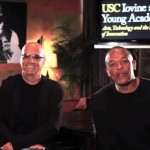 Just like a job finalist waiting for a decision, college-bound teenagers have been watching the mailbox for the telltale thick envelope that means “Yes.” Thin ones are usually bad news.
Just like a job finalist waiting for a decision, college-bound teenagers have been watching the mailbox for the telltale thick envelope that means “Yes.” Thin ones are usually bad news.
Some schools email their decision. Last week, the Ivies simultaneously released their decision online at 5 p.m. EDT Thursday. Other schools send confetti, or links to an acceptance video.
None, though, were more creative than the University of Southern California’s brand new Jimmy Iovine and Andre Young Academy for Arts, Technology, and the Business of Innovation. The accepted applicants each received a personal video with congratulations from Iovine and Young, better known as the hip-hop artist Dr. Dre. Iovine, Dre’s longtime associate, is a successful and well known music producer.
Filmed in a music studio, each message was personalized to the student with Dre looking into the camera and telling the student, “The Trojan family is excited to offer you a spot in the class of 2018.”
For several years now, colleges and universities have experimented with imaginative ways to announce their acceptance. It’s not merely to create a little excitement; the more successful they are in convincing the candidate they’re really wanted, the more likely the student is to accept the offer and go on to enroll in the Fall.
Anything sound familiar here? There are clear parallels between college admissions and job offers. Both admissions officers and recruiters seek to entice the cream of the crop; offers go out to those with the best credentials who also impress the hiring or admissions committee. In some cases, colleges, like employers, will even conduct interviews.
But there is one big exception, and that comes when the decision is made. Unlike employers, schools are becoming ever more creative in how they present their offer and in the follow-up they do. They have to: the average acceptance and enrollment of the 263 national universities that provided data to U.S. News is a paltry 35 percent. Even Harvard, with its unrivaled global academic brand and the best acceptance rate of all the schools, enrolls only 8 of every 10 students it accepts.
Few employers have rejection rates much different than Harvard’s, but a warning bell is sounding. Reports from recruiters, and especially from search firms, hint at a declining acceptance rate by candidates. An MRI survey found that more and more candidates are rejecting offers. According to the study, 42 percent of candidates refused job offers as a result of accepting an offer with another company, up from 33 percent in the first half of 2013.
In all the STEM occupations, and in many industries, sourcing, recruiting, and hiring the merely talented, let alone the so-called top talent, has become so difficult that time to hire is lengthening and jobs are going unfilled. Losing a candidate to another employer is not just disappointing. It’s costly.
This may be where borrowing from college admissions could make a difference. You may not have a celebrity to welcome your candidate, but you do have the team and hiring manager with whom that person will be working. A personalized video encouraging your candidate with a show of enthusiasm lets the candidate know they’re valued and will get a warm welcome when they start work. It’s also a great way to counter the counteroffer.
And if you do happen to have a celebrity of one kind or another, all the better.
Some of the Related Conference Sessions at the ERE Recruiting Conference in San Diego:
- Revamp Your College Recruiting Program Now: An Imperative Given the New World of Higher Education, Wednesday, April 23, 2 p.m.
- Think Like a Marketer and Ace Your Recruiting Results, Thursday, April 24, 3:15 p.m.
- Recruiting Tech Talent: Critical Strategies, Tools, and Technologies for Winning the Toughest War for Talent, Wednesday, April 23, 2 p.m.